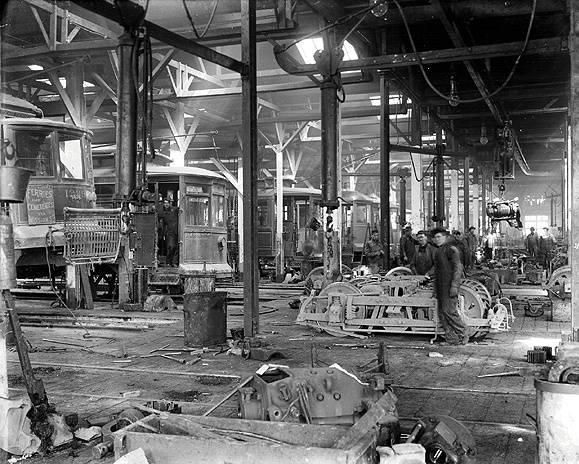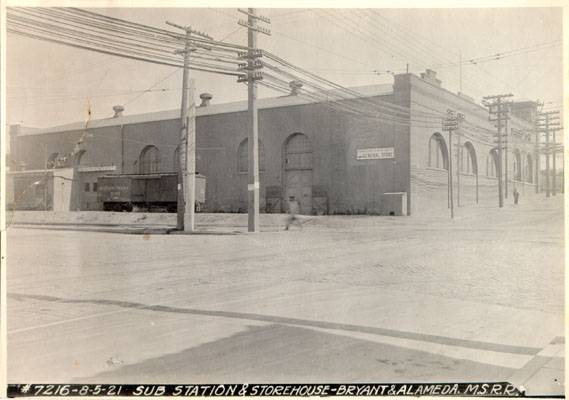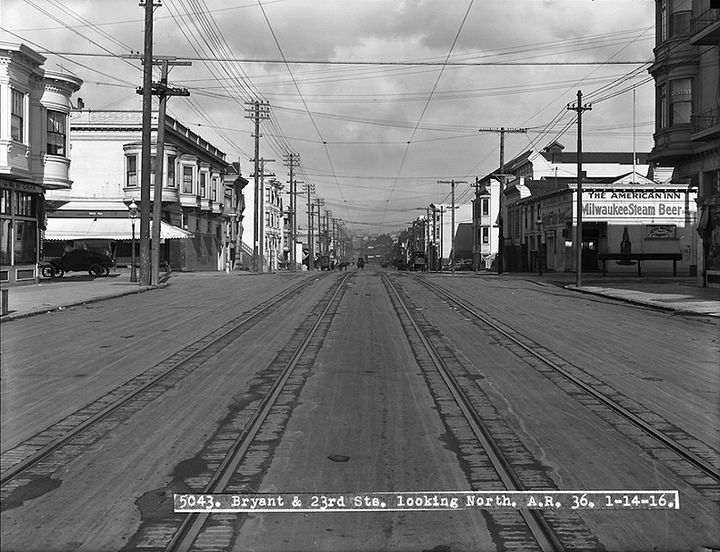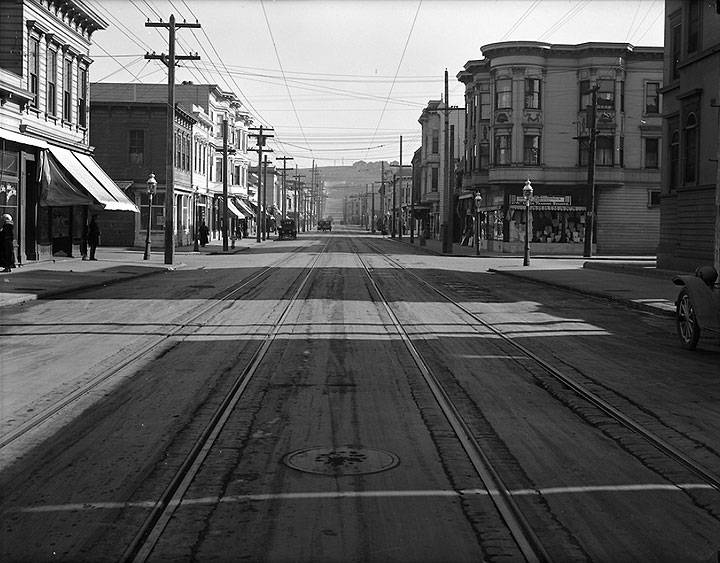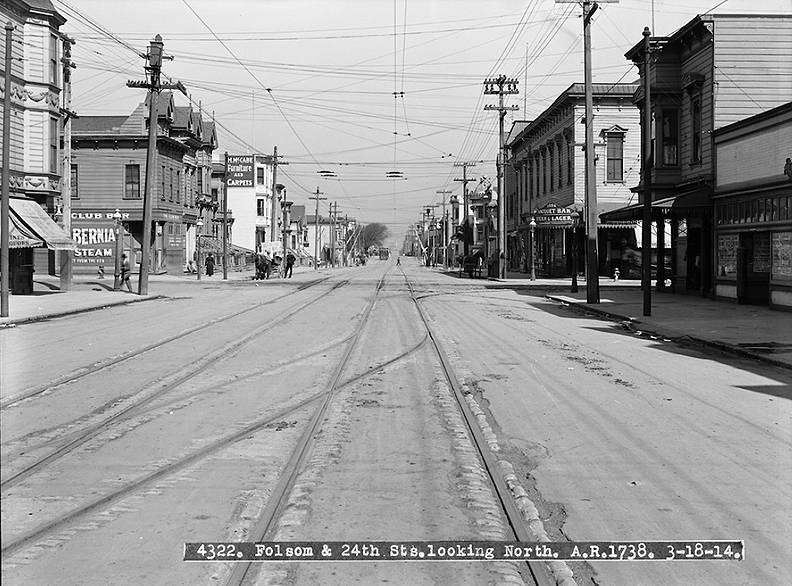United Railroads Streetcar Strike 1917: Difference between revisions
m (Protected "United Railroads Streetcar Strike 1917": finished essay [edit=sysop:move=sysop]) |
(added photo) |
||
| (14 intermediate revisions by 3 users not shown) | |||
| Line 3: | Line 3: | ||
''by Chris Carlsson '' | ''by Chris Carlsson '' | ||
[[Image:labor1$urr-carbarn-in-1917.jpg]] | |||
'''Carbarn interior, c. 1917. Strikebreakers were housed in these facilities during the protracted strike of 1917.''' | |||
''Photo: Private Collection, San Francisco, CA'' | |||
[[Image:Market Street railway barn Bryant and Alameda Aug 5 1921 AAC-8493.jpg]] | |||
'''Railway barn at Bryant and Alameda next to the breweries, August 5, 1921.''' | |||
''Photo: San Francisco History Center, San Francisco Public Library.'' | |||
<iframe src="https://archive.org/embed/ssfCARSTRIK" width="640" height="480" frameborder="0" webkitallowfullscreen="true" mozallowfullscreen="true" allowfullscreen></iframe> | |||
[http://www.archive.org/details/ssfCARSTRIK video of strikers on Haight and Buchanan, 1917] | [http://www.archive.org/details/ssfCARSTRIK video of strikers on Haight and Buchanan, 1917] | ||
'' | {| style="color: black; background-color: #F5DA81;" | ||
| colspan="2" | '''This account, based primarily on ''SF Examiner'' articles of the period, describes the strike of 1917 against United Railroads, a former streetcar service in San Francisco, by its streetcar employees. The article details the week following the initial strike by streetcar workers demanding unionization, a minimum wage, and an 8 hour day. As thousands of workers joined the strike, United Railroads brought in scab workers to work the streetcars and employees to hassle the striking workers. Daily marches and mob attacks occurred throughout the city for three months until late November when the strike was finally defeated by the company whose ultimate power lay in the use of its resources to wait out the strike and leverage an entirely new workforce.''' | |||
|} | |||
Company officials and police arrived a few minutes later. Thirty or forty of the strikers left for the Labor Temple. They had been told to congregate there. On the way they tried to get the crews of several Sixteenth street and Mission street cars to desert. They were successful with the crew of one Sixteenth street car. Demonstrations took place in the street at this point. Poles were torn from the trolleys. A brick was hurled through a car window... It was an hour before the blockade was cleared... due in great measure to the fact that the striking motormen threw their controller bars away [and] the new crews had to hunt for the bars in the streets." | |||
On August 11, 1917, at 9:45 p.m., one hundred "platform men" employed by the privately owned United Railroads (URR) streetcar service in San Francisco, abandoned their streetcars near the corner of Market, Valencia and Haight Streets, rapidly tying up many of the main lines in and out of the city center. Weeks of secret agitation had set the stage for a strong, well-organized walkout. (Almost exactly 13 months earlier--July 14, 1916--[[Rising Tensions Engulf 1916 San Francisco: Class War Precedes World War I |Tom Mooney]] and his wife Rena tried to spark a similar wildcat strike on the United Railroads, but were quickly defeated by the preparations of the company and the timely appearance of scab streetcar conductors.) The ''SF Examiner'' (8/12/1917) details the strike's beginning: | |||
<blockquote>''"The strike's leaders... arranged with the crews of three cars to block Market Street and connecting lines at a certain hour. The crews were to run slowly so that when they stopped their cars a big blockade would result. The time was set at 9:50 o'clock. Five minutes before this Car 1534 of the Valencia street line stopped at the Market street junction. A Gough, Cortland car and a Market Haight car stopped at the same time. The cars following closely on each of these lines piled up quickly. The blockade was effective. The crews stood by their cars for a few minutes. Some removed their badges and mingled with the big crowd that collected. They all announced that they were on strike, that they were not satisfied with wages or hours or conditions. '' <br> | |||
"Company officials and police arrived a few minutes later. Thirty or forty of the strikers left for the Labor Temple. They had been told to congregate there. On the way they tried to get the crews of several Sixteenth street and Mission street cars to desert. They were successful with the crew of one Sixteenth street car. Demonstrations took place in the street at this point. Poles were torn from the trolleys. A brick was hurled through a car window... It was an hour before the blockade was cleared... due in great measure to the fact that the striking motormen threw their controller bars away [and] the new crews had to hunt for the bars in the streets."</blockquote> | |||
The strike quickly spread, as URR workers quickly joined the strike and within just a few days over 1,000 were on strike demanding union recognition, $3.50 a day, and an 8 hour workday. Daily parades of strikers surged through the streets, all the way to the ferries and back up Market and Mission streets, exhorting those still working to walk off and join the strike. Mass meetings were held at the Redstone Building ([[Redstone Murals list|at 16th and Capp]]), where delegations were selected to visit major industrial sites around town, such as the Union Iron Works, to rally workers to abandon the URR streetcars, while others headed for outlying carbarns to enlist more workers to strike. | The strike quickly spread, as URR workers quickly joined the strike and within just a few days over 1,000 were on strike demanding union recognition, $3.50 a day, and an 8 hour workday. Daily parades of strikers surged through the streets, all the way to the ferries and back up Market and Mission streets, exhorting those still working to walk off and join the strike. Mass meetings were held at the Redstone Building ([[Redstone Murals list|at 16th and Capp]]), where delegations were selected to visit major industrial sites around town, such as the Union Iron Works, to rally workers to abandon the URR streetcars, while others headed for outlying carbarns to enlist more workers to strike. | ||
<iframe src="https://archive.org/embed/UnitedRa1917" width="640" height="480" frameborder="0" webkitallowfullscreen="true" mozallowfullscreen="true" allowfullscreen></iframe> | |||
'''1917 strikers march against United Railroads' open shop.''' | |||
''Video: [http://www.archive.org/details/prelinger Prelinger Archive]'' | |||
Meanwhile mobs repeatedly attacked scab streetcars throughout the city. On August 13 police dispersed crowds at Bryant and 24th streets in the Mission and at 8th and Market. By the 14th, the strike had spread so thoroughly that the URR was forced to shut most of its lines. | Meanwhile mobs repeatedly attacked scab streetcars throughout the city. On August 13 police dispersed crowds at Bryant and 24th streets in the Mission and at 8th and Market. By the 14th, the strike had spread so thoroughly that the URR was forced to shut most of its lines. | ||
[[Image:Bryant-and-23rd-north Jan-14-1916 U05043.jpg|720px]] | |||
'''Bryant and 23rd Streets, looking north, Jan. 14, 1916, less than a year before the violent 1917 strike broke out.''' | |||
''Photo: [http://sfmta.com/photo SFMTA Photo] U05043'' | |||
[[Image:24th-east-betw-Alabama-and-Florida-Nov-25-1918 U06333-.jpg]] | |||
'''24th Street looking east between Alabama and Florida, November 25, 1918.''' | |||
''Photo: [http://sfmta.com/photo SFMTA Photo] U06333'' | |||
On the 15th a scab-driven inbound Sutter line car rammed into an outbound Municipal streetcar at Market and Sansome. Strike sympathizers tried to pull the scabs off the streetcar and in the ensuing melee, two URR employees were identified as "gunmen" to the police. Upon being arrested they were discovered to be holding three revolvers and a couple of blackjacks between them. | On the 15th a scab-driven inbound Sutter line car rammed into an outbound Municipal streetcar at Market and Sansome. Strike sympathizers tried to pull the scabs off the streetcar and in the ensuing melee, two URR employees were identified as "gunmen" to the police. Upon being arrested they were discovered to be holding three revolvers and a couple of blackjacks between them. | ||
| Line 29: | Line 59: | ||
In an incident typical of the low-intensity violence that characterized this strike, the ''Examiner'' reports on August 16 the following: | In an incident typical of the low-intensity violence that characterized this strike, the ''Examiner'' reports on August 16 the following: | ||
''"Edgar Hicks, a striker, boarded a [scab] streetcar at 21st and Folsom, and after paying his fare, asked the men to join the strikers. He was immediately set upon by a pair of [URR thugs], who were armed with iron bars and police clubs, and was severely beaten about the head and face... The prisoners were later released on $100 bail furnished by the United Railroads." '' | <blockquote>''"Edgar Hicks, a striker, boarded a [scab] streetcar at 21st and Folsom, and after paying his fare, asked the men to join the strikers. He was immediately set upon by a pair of [URR thugs], who were armed with iron bars and police clubs, and was severely beaten about the head and face... The prisoners were later released on $100 bail furnished by the United Railroads." ''</blockquote> | ||
[[Image:24th-and-Folsom-March-18-1914.jpg]] | |||
'''Folsom northerly at 24th, March 18, 1914, the days when streetcars crisscrossed the neighborhood.''' | |||
''Photo: [http://sfmta.com/photo SFMTA Photo] U04322'' | |||
On August 17, another 100 men joined the strike, bringing the total to over 1,600 of the original 1,800 workers. Seven men in an automobile following the strikers' daily parade were arrested, and a search of their car discovered revolvers, clubs and other weapons. Five said they had just come from Los Angeles to work for URR, and that they were following the parade to incite a street riot. Two other carloads of men got away during the arrest. The arrested were released on bail posted by URR. On August 18 it was announced that an investigation had begun to determine which gun dealer had illegally sold 200 pistols to the United Railroads. | On August 17, another 100 men joined the strike, bringing the total to over 1,600 of the original 1,800 workers. Seven men in an automobile following the strikers' daily parade were arrested, and a search of their car discovered revolvers, clubs and other weapons. Five said they had just come from Los Angeles to work for URR, and that they were following the parade to incite a street riot. Two other carloads of men got away during the arrest. The arrested were released on bail posted by URR. On August 18 it was announced that an investigation had begun to determine which gun dealer had illegally sold 200 pistols to the United Railroads. | ||
| Line 41: | Line 77: | ||
But after all that, the URR held out for months more, employing over 1,000 strikebreakers, many of them blacks hired in Chicago and brought in by train, and the strike was finally defeated by late November. | But after all that, the URR held out for months more, employing over 1,000 strikebreakers, many of them blacks hired in Chicago and brought in by train, and the strike was finally defeated by late November. | ||
<hr> | |||
[[Image:Tours-transit.gif|link=Ferries on the Bay]] [[Ferries on the Bay| Continue Transit History Tour]] | |||
<hr> | |||
[[Image: | [[Image:Tours-labor.gif|link=Shipyards in Decay]] [[Shipyards in Decay| Continue Labor History Tour]] | ||
[[Bloody Tuesday|Prev. Document]] [[Carpenters' Strike April 1926 |Next Document]] | [[Bloody Tuesday|Prev. Document]] [[Carpenters' Strike April 1926 |Next Document]] | ||
Latest revision as of 19:00, 4 September 2020
Historical Essay
by Chris Carlsson
Carbarn interior, c. 1917. Strikebreakers were housed in these facilities during the protracted strike of 1917.
Photo: Private Collection, San Francisco, CA
Railway barn at Bryant and Alameda next to the breweries, August 5, 1921.
Photo: San Francisco History Center, San Francisco Public Library.
<iframe src="https://archive.org/embed/ssfCARSTRIK" width="640" height="480" frameborder="0" webkitallowfullscreen="true" mozallowfullscreen="true" allowfullscreen></iframe>
video of strikers on Haight and Buchanan, 1917
| This account, based primarily on SF Examiner articles of the period, describes the strike of 1917 against United Railroads, a former streetcar service in San Francisco, by its streetcar employees. The article details the week following the initial strike by streetcar workers demanding unionization, a minimum wage, and an 8 hour day. As thousands of workers joined the strike, United Railroads brought in scab workers to work the streetcars and employees to hassle the striking workers. Daily marches and mob attacks occurred throughout the city for three months until late November when the strike was finally defeated by the company whose ultimate power lay in the use of its resources to wait out the strike and leverage an entirely new workforce. |
On August 11, 1917, at 9:45 p.m., one hundred "platform men" employed by the privately owned United Railroads (URR) streetcar service in San Francisco, abandoned their streetcars near the corner of Market, Valencia and Haight Streets, rapidly tying up many of the main lines in and out of the city center. Weeks of secret agitation had set the stage for a strong, well-organized walkout. (Almost exactly 13 months earlier--July 14, 1916--Tom Mooney and his wife Rena tried to spark a similar wildcat strike on the United Railroads, but were quickly defeated by the preparations of the company and the timely appearance of scab streetcar conductors.) The SF Examiner (8/12/1917) details the strike's beginning:
"The strike's leaders... arranged with the crews of three cars to block Market Street and connecting lines at a certain hour. The crews were to run slowly so that when they stopped their cars a big blockade would result. The time was set at 9:50 o'clock. Five minutes before this Car 1534 of the Valencia street line stopped at the Market street junction. A Gough, Cortland car and a Market Haight car stopped at the same time. The cars following closely on each of these lines piled up quickly. The blockade was effective. The crews stood by their cars for a few minutes. Some removed their badges and mingled with the big crowd that collected. They all announced that they were on strike, that they were not satisfied with wages or hours or conditions.
"Company officials and police arrived a few minutes later. Thirty or forty of the strikers left for the Labor Temple. They had been told to congregate there. On the way they tried to get the crews of several Sixteenth street and Mission street cars to desert. They were successful with the crew of one Sixteenth street car. Demonstrations took place in the street at this point. Poles were torn from the trolleys. A brick was hurled through a car window... It was an hour before the blockade was cleared... due in great measure to the fact that the striking motormen threw their controller bars away [and] the new crews had to hunt for the bars in the streets."
The strike quickly spread, as URR workers quickly joined the strike and within just a few days over 1,000 were on strike demanding union recognition, $3.50 a day, and an 8 hour workday. Daily parades of strikers surged through the streets, all the way to the ferries and back up Market and Mission streets, exhorting those still working to walk off and join the strike. Mass meetings were held at the Redstone Building (at 16th and Capp), where delegations were selected to visit major industrial sites around town, such as the Union Iron Works, to rally workers to abandon the URR streetcars, while others headed for outlying carbarns to enlist more workers to strike.
<iframe src="https://archive.org/embed/UnitedRa1917" width="640" height="480" frameborder="0" webkitallowfullscreen="true" mozallowfullscreen="true" allowfullscreen></iframe>
1917 strikers march against United Railroads' open shop.
Video: Prelinger Archive
Meanwhile mobs repeatedly attacked scab streetcars throughout the city. On August 13 police dispersed crowds at Bryant and 24th streets in the Mission and at 8th and Market. By the 14th, the strike had spread so thoroughly that the URR was forced to shut most of its lines.
Bryant and 23rd Streets, looking north, Jan. 14, 1916, less than a year before the violent 1917 strike broke out.
Photo: SFMTA Photo U05043
24th Street looking east between Alabama and Florida, November 25, 1918.
Photo: SFMTA Photo U06333
On the 15th a scab-driven inbound Sutter line car rammed into an outbound Municipal streetcar at Market and Sansome. Strike sympathizers tried to pull the scabs off the streetcar and in the ensuing melee, two URR employees were identified as "gunmen" to the police. Upon being arrested they were discovered to be holding three revolvers and a couple of blackjacks between them.
URR brought in hundreds of strikebreakers and housed them in carbarns: 50 men at 24th and Utah (near SF General Hospital), 180 at 28th and Valencia, 75 at the Geneva barn, and 150 at Turk and Fillmore.
In an incident typical of the low-intensity violence that characterized this strike, the Examiner reports on August 16 the following:
"Edgar Hicks, a striker, boarded a [scab] streetcar at 21st and Folsom, and after paying his fare, asked the men to join the strikers. He was immediately set upon by a pair of [URR thugs], who were armed with iron bars and police clubs, and was severely beaten about the head and face... The prisoners were later released on $100 bail furnished by the United Railroads."
Folsom northerly at 24th, March 18, 1914, the days when streetcars crisscrossed the neighborhood.
Photo: SFMTA Photo U04322
On August 17, another 100 men joined the strike, bringing the total to over 1,600 of the original 1,800 workers. Seven men in an automobile following the strikers' daily parade were arrested, and a search of their car discovered revolvers, clubs and other weapons. Five said they had just come from Los Angeles to work for URR, and that they were following the parade to incite a street riot. Two other carloads of men got away during the arrest. The arrested were released on bail posted by URR. On August 18 it was announced that an investigation had begun to determine which gun dealer had illegally sold 200 pistols to the United Railroads.
On Sunday August 19, 2,000 strikers and their families paraded down Market street at noon, culminating in a mass meeting at Exposition Hall in the Civic Center. Banners in the parade state imploringly, "Family of 8. Could you support them on $3 a day?"
During the meeting, one speaker embraced the strike's mainstream quality: "We are neither I.W.W.'s nor slackers. If there is lack of patriotism or respect for the law in this strike, it is not on the side of the strikers."
On August 28, mob attacks were reported at Utah and 24th, 16th and Mission, 23rd and Folsom, 20th and Howard, and a brick attack on an inbound San Bruno car between Cortland and Oakdale. More mob attacks and bullets fired at streetcars in the Mission, the Sunset (at 10th and Lincoln) and elsewhere occurred daily.
But after all that, the URR held out for months more, employing over 1,000 strikebreakers, many of them blacks hired in Chicago and brought in by train, and the strike was finally defeated by late November.

